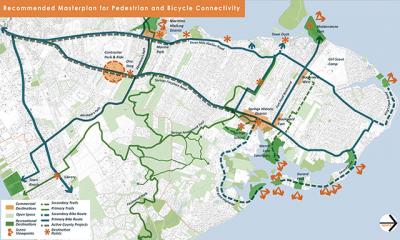Ex East Hampton Political Leaders Face Fraud Charges
Ex East Hampton Political Leaders Face Fraud Charges

Two former East Hampton political party leaders are among four people on the East End being charged with fraud related to signatures gathered on nominating petitions ahead of November's election, the Suffolk County District Attorney's office said.
Online records show that Amos Goodman, who resigned last week as the East Hampton Town Republican Committee chairman, and Pat Mansir, the former vice chairwoman of the East Hampton Independence Party and a former East Hampton Town Councilwoman, are facing felony charges.
Mr. Goodman, a 35-year-old Springs resident who ran for Suffolk County legislator in 2015, is facing 10 counts of criminal possession of a forged instrument in the second degree and 10 counts of offering a false instrument for filing in the first degree. He is alleged to have submitted nominating petitions, including for Green Party judicial candidates, that contained at least 43 forgeries, the D.A.'s office said late Tuesday night. One signature was of a person who is deceased, the D.A. alleged.
He is scheduled for arraignment Wednesday morning in Suffolk County District Court in Islip.
Meanwhile, Ms. Mansir was arraigned Tuesday on eight charges — four counts of possession of a forged instrument and four counts of offering a false instrument for filing in the first degree. The D.A.'s office said she submitted nominating petitions for her party's candidate that contained eight forged signatures, including one person who was deceased. Justice Jennifer A. Henry released her on her own recognizance.
"My client denies the allegations and looks forward to being proven innocent, though she never should have been put in a position to have to defend her good name," Carl Irace, an East Hampton attorney who is representing Ms. Mansir, said late Tuesday night. Ms. Mansir did not immediately return a request for comment on Tuesday night.
Mr. Goodman could not immediately be reached Tuesday night. It was not clear who his attorney was.
The D.A.'s office also announced the arrest of two other men, William Mann, 60, of Cutchogue, and Gregory Dickerson, 55, of Mattituck, who were charged with unrelated petition fraud, as well. Both are Suffolk County Board of Elections employees.
“Through their alleged actions, the defendants corrupted the democratic process and violated the public’s trust,” Suffolk District Attorney Tim Sini said. “This brazen scheme to get preferred candidates on the November 2018 ballot by any means necessary included the alleged filing of petitions with forged signatures, some of which included forged signatures of deceased individuals. In addition, one of the defendants is alleged to have used his position as a member of the Suffolk County Board of Elections to deceive voters into signing petitions they might otherwise have declined to sign. This kind of conduct is unacceptable; if you abuse your position of public trust and attempt to disrupt the integrity of the election process, you will be brought to justice.”
The Republican Committee asked for Mr. Goodman's resignation two weeks ago, after it became aware of an investigation by the Public Integrity Bureau of the Suffolk County District Attorney’s office. The D.A.'s office said it received complaints from representatives of the Suffolk County Green Party, the East Hampton Town Republican Party and the East Hampton Town Independence Party.
The investigation was said to be focused on the validity of nominating petitions submitted by Mr. Goodman for the Republican Party’s candidate, Manny Vilar, in the special election for a seat on the town board. Elaine Jones, the chairwoman of the East Hampton Independence Party, had made allegations of fraudulent signatures after Mr. Goodman previously leveled the same accusation at the Independence Party.
David Lys, who had been appointed to the vacant seat in January, won the Nov. 6 election in a landslide, with unofficial results giving him 69 percent of the vote, versus Mr. Vilar's 31 percent.
The Independence Party had chosen David Gruber, a Democrat, over Mr. Lys and Mr. Vilar for its nomination. Ms. Mansir gathered signatures for Mr. Gruber's nominating petitions. The East Hampton Town Republican Committee challenged the petitions, and New York State Supreme Court Justice Carol MacKenzie ostensibly agreed with the East Hampton Town Republican Committee, which had challenged the petitions, writing in August that they were "replete with fraudulent dates and forged signatures and/or initials of signatories and/or subscribing witnesses."
Mr. Gruber's name did not appear on the ballot after the petitions were voided.
The investigation did not reveal evidence that any of the candidates were aware of or involved in the alleged schemes, the D.A.'s statement said.
Ms. Mansir, 72, who lives in East Hampton, has long been involved in politics. She was a town councilwoman for 12 years and served for 10 years on the East Hampton Town Planning Board. She last held public office in 2017, when she resigned in her first term as an East Hampton Town Trustee, expressing growing frustration with colleagues who “diminish and restrict” other trustees and with what she described as the panel’s dysfunction. When she ran for town trustee she did so as a Democrat and was elected with Independence endorsement.
Mr. Goodman runs a corporate advisory firm focused on the aerospace and defense industries. He assumed chairmanship of the Republican committee in 2017.
If convicted of the top count of criminal possession of a forged instrument, each defendant faces a maximum sentence of two and one-third to seven years in prison.
With Reporting by Christopher Walsh
This article was updated since it was first published.



